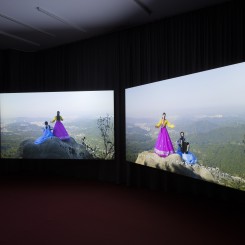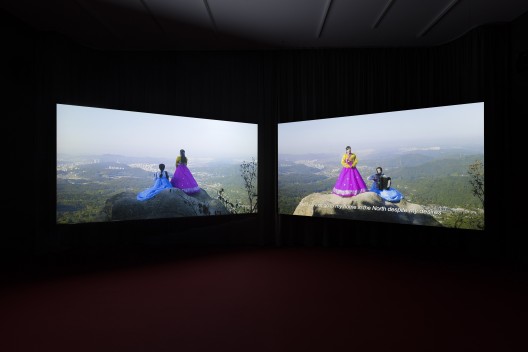IM Heung-soon, Tao Hui , Minjung Kim, Prabhavathi Meppayil, Pak Sheung Chuen
Esther Schipper (78-87 Potsdamer Strasse, Berlin – new address) January 20 – February 25, 2017
In the roots of Western culture, walking up a mountain begins with the Greek myth of Sisyphus, the King of Ephyra who, depending on the story, was condemned by the gods for overweening pride, wisdom, duplicity, and defiance—each shades of independence. His penance: to repeatedly push a boulder up a mountain for eternity. The parable encompasses notions of justice and punishment, social and political order, and the value of work, life and happiness, each measured in time and space, repetition and weight. “Zum Raum wird hier die Zeit” (Here space becomes time) says Gurnemanz to Parsifal in Wagner’s opera. Time marks the process of becoming, space its stage, but neither time nor space care for the clock is a fiction, a narrative that exists only in the mind—the clock remarks not its own counting. And yet, as mere people subject to the will of the gods, with concentration we can ignore time and space. We have only to concentrate, to learn to watch the stone grow. The gods become ghosts, and West becomes East.
“The Mulberry Forrest Becoming Ocean” was Esther Schipper’s last show at its Schoeneberger Ufer premises before reopening this month in the former Tagesspiegel newspaper building in Potsdamer Strasse. It was the gallery’s second exhibition devoted to Asian artists. In 2008, Philip Tinari, now director of the UCCA in Beijing, curated “CYLWXZ” with Chu Yun, Liu Wei, and Xu Zhen, all from China. Curated by gallery director Shi-Ne Oh, “The Mulberry Forrest” includes five artists: Pak Sheung Chuen (b. 1977, Fujian, China), IM Heung-soon (b. 1969 in Seoul, South Korea), Tao Hui (b. 1987, Chongqing, China), Minjung Kim (b. 1962, Gwangju, South Korea), and Prabhavathi Meppayil (b. 1965, Bangalore, India).
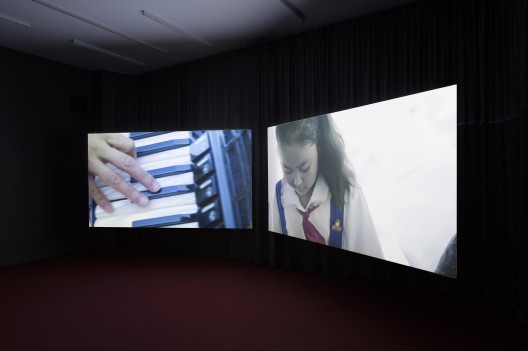
Tao Hui, “Excessive”, 2015, HD video (color, sound), glass projector, silica gel, iron, wood, 112 x 59,8 x 30 cm, duration: 19:32 min, edition of 5. (image courtesy the artist and Esther Schipper)
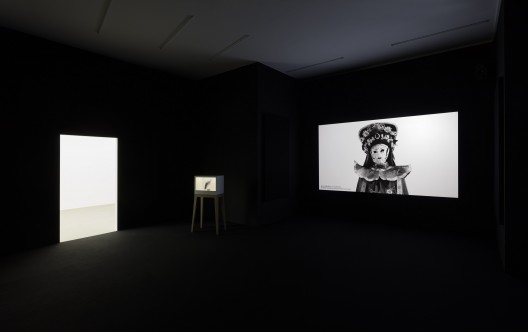
Tao Hui, “Excessive”, 2015, HD video (color, sound), glass projector, silica gel, iron, wood, 112 x 59,8 x 30 cm, duration: 19:32 min, edition of 5.
There was no preordained way to view the “Mulberry Forrest” yet it seemed to begin and end with narrative films. In a darkened room built within the usual gallery space were two films and an installation by Tao Hui. The first film, “Excessive” (2015) recounts the story of how a family reacts to the daughter having an extra finger, a trivial but definite marker of otherness. The actors play naturalistically but against a white background that signals the story’s artifice (similarly, rain is represented by falling black feathers). The players draw stylistically on Chinese soap operas, with moments of arch stillness or sudden emotion punctuating the film’s naturalism. The narrative is about generations, particularly the tension between middle class ambition and conformity. It is also a film about male hysteria, the symptom being the projection—and the film itself is a projection, a mirror, an artifice, a trick. To reinforce the point again, we see a Sichuan face changer perform.
Projected onto an adjacent wall to the right was “Talk About Body” (2013), a short video showing a Chinese woman wearing a Muslim headscarf, sitting on a bed in a small, crowded room, answering questions put to her. On the wall hangs a photograph of a girl’s arm and hand with an extra finger—a promise to the future. Flanking the left side of the main film stood a small play-box version of the larger film, raised on four legs, reiterating the artifice of the projection and the position of the viewers, who also stood in a box—the darkened room itself.
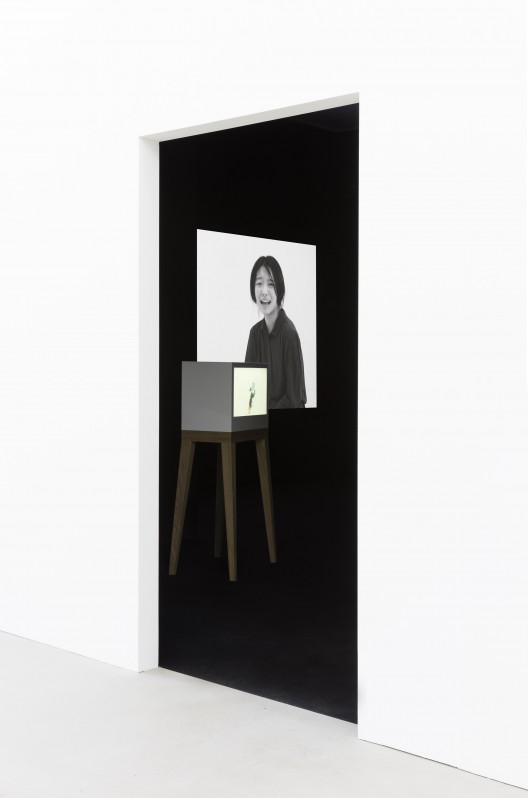
Tao Hui, “Excessive”, 2015, HD video (color, sound), glass projector, silica gel, iron, wood, 112 x 59,8 x 30 cm, duration: 19:32 min, edition of 5. (image courtesy the artist and Esther Schipper)
Emerging from Tao’s theatre into the light again, the tension from the bloody dénouement of “Excessive” dissipated. Hanging on the walls were a series of paper works by Minjung Kim, “drawings” created by carefully burning seemingly geometric holes and patterns on Korean Hanji paper. The charring and layering of multiple papers adds a sense of eclipse and depth, but also reminds one of petri dishes and the work of silkworms on Mulberry leaves and metamorphosis, whether into the Bombyx moth, silk cloth or Hanji paper, which is made from the inner layers of bark of Mulberry trees that grow on the sides of mountains in Korea. Informed by Korean process art as well as traditional ink art, Kim’s drawing returns the beholder to the beginning, the means of becoming. “Drawing” is a noun and an infinitive. Nothing has been ‘drawn out’ per se, no ink or graphite, but substance has been removed by burning, which is a return to gas and carbon, progression mirroring regression. These works, with titles such as “Insight” and “Phasing”, need to be lived with, with the shift of daily and seasonal light, circadian rhythms and changing moods. To put it another way, Sisyphus must realize that the rock is him. I was also reminded of earlier exhibitions that relied on the play of light on the same wall, such as that of Ann Veronica Janssen’s in 2015. One last point. It is wonderfully edifying to meet Kim herself and to learn that such deeply contemplative works are created by a very cheeky and light-filled person.
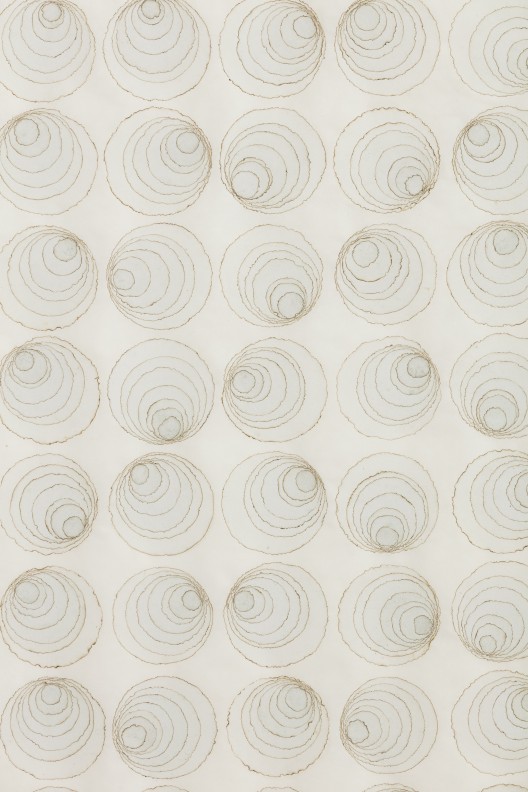
Minjung Kim, “Insight”, 2006, Mixed media on mulberry Hanji paper, 140 x 140 cm (unframed), 154 x 154 x 6 cm (framed) (MK 001) (image courtesy the artist and Esther Schipper)
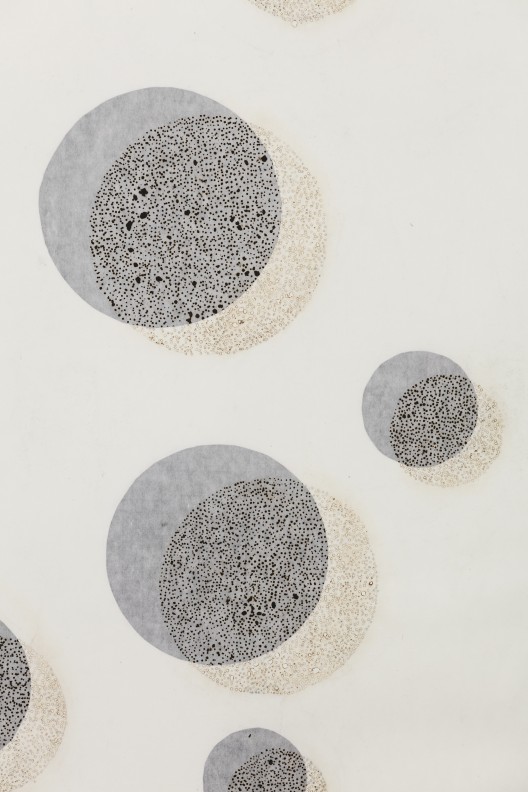
Minjung Kim, “Phasing”, 2016, mixed media on mulberry Hanji paper, 145 x 205 cm (unframed), 160 x 224 x 6 cm (framed) (image courtesy the artist and Esther Schipper)
In a similar process-vein, Prabhavathi Meppayil creates works by meticulously hand-sanding away layers of gesso to reveal lines of copper thinnam embedded in it. (Thinnam is a type of fine wire used by goldsmiths in India, including Meppayil’s family, for decorative purposes). Traditionally, gesso is a mixture of the minerals chalk and gypsum with an animal-based binder to create a white substratum for painting on canvas and board, and sometimes for sculpture. In a sense, each work may be read as a reincarnation of the previous works—a re-making and a re-marking. Each represents a position within Modernism’s canon; a search for meaning in formalism and a record of the performance of its making. But each is also merely a record of the performance, the remains of the work, of all the cultural and personal associations. Meppayil creates her own new tradition whilst also acknowledging the traditions of modernism and her family, of East (India) and West (Modernism). It does not represent a reconciliation of traditions but an ambiguous and shamanistic collision of metal, mineral, and animal; metabolism, history, and culture.
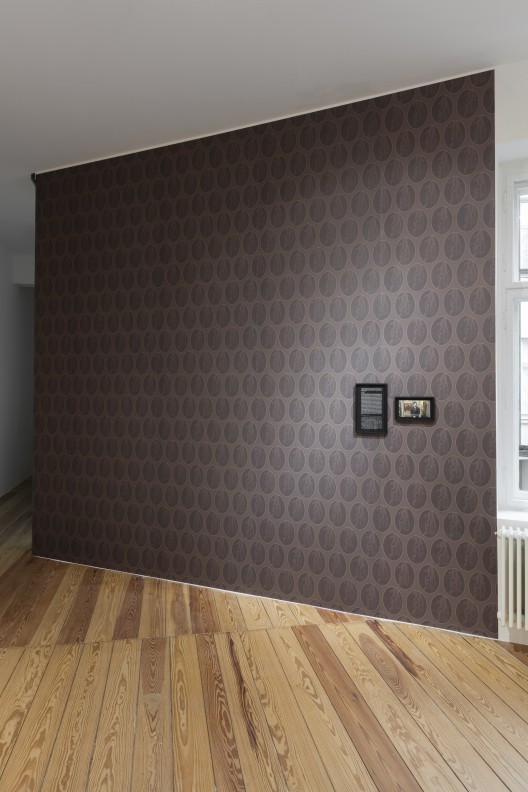
Pak Sheung Chuen, “Nightmare Wallpaper” (No.STC2360-15/a), 2016, wallpaper with framed document, drawings, photographs Dimensions variable (image courtesy the artist and Esther Schipper)
Kim’s circles are picked up in the next chapter of the exhibition. Pak Sheung Chuen’s dark “Nightmare Wallpaper” (2016) covers one wall, a grid of ovals that order chaotic images relating to Hong Kong protestor, Mr Tsang, who was arrested and charged with throwing eggs at the territory’s Chief Executive of Hong Kong, Mr Leung Chun-Ying, in the course of 2014’s pro-democracy protests. Hanging on the wall is the artist’s own record of the court hearing, which he attended, along with a photograph taken from a television news report showing the defendant standing outside the court, smiling. The grid makes the images anodyne, just as the verdict makes the protest merely a ‘common assault’. The images can be seen by everyone who glances at the wall, but they are hard to read, so you must look carefully. In the photograph, behind Mr Tsang, an ovoid shape with a yellow edge can be glimpsed. The chaotic images inside the wallpaper ovals, including men in a fire in a cave, are taken from Pak’s drawings made in the court room and also refer—elliptically actually—to the biblical story of Daniel, who served the Babylonian king, Nebuchadnezzar (temporal law), whilst remaining true to his faith (spiritual law). To ‘wallpaper over something’ is to cover up an embarrassing history, but here the history has seeped through, or rather the cover-up has been shown to be a crime in itself.
Opposite, a ‘forest’ of different lengths of wood leans against the wall: “12 Vertical Tree Trunks And A Slanted Forest”—the shadows being the verticals. Again we are reminded of the play between surface and reality. A series of four semi-aerial photographs show Pak outside in some sort of concrete area, the surface weathered and cracked. The artist appears to take water from one puddle to another, his wet and drying footsteps leading back and forth between them.
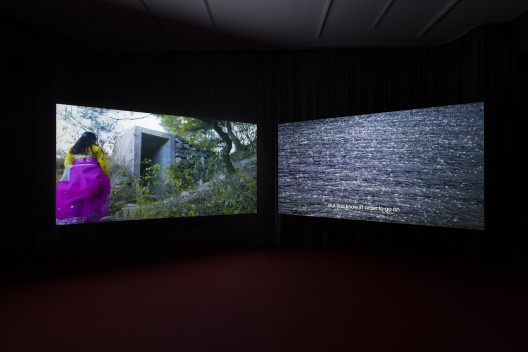
Im Heung-soon, “Bukhansan/Bukhangang”, 2015-2016, HD, 2-channel video, 5.1 Ch sound, duration: 28:12 min, edition of 5 (image courtesy the artist and Esther Schipper)
We have reached the dénouement. Inside another darkened pavilion is a two-screen video, IM Heung-soon’s “Bukhansan/Bukhangang”, a mediation on the division of Korea from the personal experience of a woman migrant from the North to the South, forever caught between worlds. The two screens swap between singer Kim Bok-ju recounting her life while climbing a mountain in a bright yellow and pink traditional costume, and scenes recounting her childhood in North Korea prior to defecting, including on the Han river in a recreational park. She is seen mainly from behind as she indefatigably climbs up a steep, forested path, passing an abandoned concrete military outpost, until finally she appears to arrive at the summit, shown on both screens from different directions. The truth is that only one is Kim Bok-ju.
The word ‘bokhusan’ means both ‘mountain’ and ‘mountain in the north’, marking a literal disjunction between twin worlds. Meanwhile, ‘Bukhangang’ refers to a tributary of the Han river that crosses the demilitarized zone, connecting both countries. The double screen device—and the double Kim Bok-jus—thus plays on the geological, political, and personal disjunctions of the two Koreas. If that sounds contrived, it is not. The viewer climbs with Bok-ju as a tourist to the film’s non-linear diegesis and interplay of images, lulled by correspondences of colors and movement, notably with Kim’s dress but also the landscape, sky, and water.
“The Mulberry Forest Becoming Ocean” is not a collection of disparate artists lashed to a random curatorial idea, like so many group shows. For those with patience, it revealed itself slowly as a series of meditations not only on surfaces and experience, but also relative to the purpose of art and narrative and how its practice—its making—is its purpose. There is no denouement. The films start again. You walk back through the rooms. And later it plays out again in the mind, half remembered but insistent.
In Berlin, there is a waste disposal company whose name is Sisyphos. Fortunately, Berlin is almost flat.
